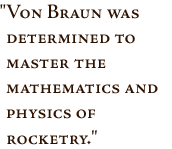

|
One day in 1925, von Braun saw an ad in an astronomy magazine about a book called "The Rocket to the Interplanetary Spaces," by Professor Hermann Oberth. He ordered the book at once and, when it arrived, opened it breathlessly. To his consternation, he couldn't understand a word—its pages were a baffling conglomeration of mathematical symbols and formulae. Rushing to his teacher, he cried, "How can I understand what this man is saying?" To von Braun's dismay, his teacher told him to study mathematics and physics, but with the glamorous prospect of a life devoted to space travel, these subjects took on a new meaning. Von Braun was determined to master them and he began to bury himself in their mysteries and, after a few years, he succeeded in graduating a year ahead of his class. After graduating from school, von Braun became a student at the Berlin Institute of Technology and worked in his spare time as an assistant for Professor Oberth at the German Society for Space Travel. Oberth was trying to prove that liquid fuels, instead of solids, offered the best approach to powering rockets for space vehicles. Oberth's other two assistants were Klaus Riedel and Rudolf Nebel. Their equipment was crude and the ignition system was perilous. Riedel would toss a flaming gasoline-soaked rag over the gas-spitting motor and duck for cover before Oberth opened the fuel valves, and then the motor would start with a roar!
Oberth and his assistants were allowed to conduct experiments as guests on the proving grounds of the Chemical and Technical Institute, the German equivalent of the U.S. Bureau of Standards. In August 1930, Oberth's little rocket engine succeeded in producing a thrust of seven kilograms for 90 seconds, burning gasoline and liquid oxygen. An official of the Institute certified the demonstration and the liquid-fueled rocket motor was thus recognized for the first time in Germany as a respectable member of the family of internal-combustion engines. This was a tremendous step forward but, because he had to support a large family, Oberth was forced to return to his teaching job in Romania. After Oberth's departure, the team's guest status at the proving grounds expired and a new place to conduct the experiments had to be found. Nebel secured a lease on an abandoned 300-acre ammunition storage depot on the outskirts of Berlin. He persuaded the city fathers to let them use the site free-of-charge and for an indefinite period. One of the blockhouses was used as the laboratory and on this building was hung the sign "Raketenflugplatz Berlin" (Berlin Rocket Field). Nebel did an amazing job of scrounging free materials, which were swapped for skilled labor, such as tin bending or welding. Riedel sketched out a design for a "Minimum Rocket," which they started to build. The motor was located in the nose, not for any scientific reason, but simply because Nebel had scrounged a truckload of aluminum tubing which could only be used if the motor dragged the tanks by the fuel lines. next: A Public Firing
|
 On the Shoulders of Giants
| ||